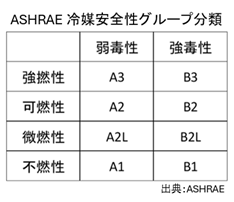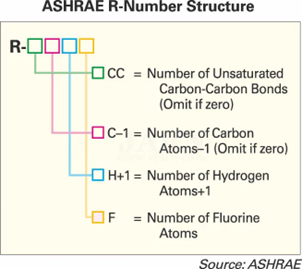NPO法人環境エネルギーネットワーク21主任研究員 石橋直彦
R番号は、米国暖房冷凍空調学会(ASHRAE)がASHRAE規格34“冷媒の指定及び安全分類”に基づいて冷媒に割り当てるもので、国際的に認められており、冷媒の毒性と可燃性を指定・分類するものである。
2025年2月10日、ASHRAE 34委員会は、最初の2つの4桁混合冷媒シリーズの公開審査と公開を承認した。これにより、R番号は3桁を超え、新たな4桁時代へと移行した。これは、非共沸混合冷媒の混合組成数が99種類を超えたためである。現在、R-170とR-290の混合物であるR-499Aが3桁のR番号の最後であり、R-32、R-152am及びR-13I1の混合物であるR-4101Aと、R-134a、R-1234ze(E)及びR-1233zd(E)の混合物であるR-4102Aが最初の4桁の混合物シリーズとなり、ASHRAEと米国規格協会(ANSI)の公開審査を受けているところである。R-4100は意図的に割り当てしないままにされている。
ASHRAE冷媒番号は、化学名、式、又は商標名を使用せずに一般的な冷媒を参照する簡単な方法として開発された。これらの番号は、安全分類とともに、申請者が提出した毒性及び可燃性データに基づき、委員会メンバーによる提供データの綿密な審査を経てASHRAE 34によって指定される。
純粋化合物の場合、化学式の水素、炭素、フッ素原子及びその異性体から独自の方法で番号が付けられる。異性体とは、同じ化学式でありながら分子内の原子の配置が異なり、特性が異なる分子のことである。これらの分子はR-134a のように番号の後に小文字を付けて指定する。
同じ純粋成分を含みながらもその割合が異なる冷媒混合物は、番号の後に大文字を付けて区別する。R-407 シリーズは、R-32、R-125及び R-134a の混合物で、R-407A から R-407I まで 9 つの異なる組成比を持つ最も多くの種類がある。R-4xx に分類される冷媒は非共沸混合冷媒である。すなわち、2 種類以上の冷媒の混合物であり、液相と気相の組成は常に異なる。一方、R-5xx シリーズの冷媒は共沸混合冷媒である。これは、特定の圧力で液相と気相の組成が同じになる混合冷媒である。よく知られている冷媒である R-410A は非共沸混合物であるが、“擬似共沸混合物”と考えられている。
さらに、ASHRAE規格34では、各冷媒に識別用の文字と番号を割り当てるだけでなく、毒性と可燃性も分類している。
大文字は許容暴露レベルに基づく毒性クラスを表し、数字は可燃性を示す。ASHRAE規格34によれば、冷媒は2つの毒性クラスに分類される。クラスAは毒性の低い冷媒を指し、クラスBは毒性の高い冷媒に割り当てられる。一方、可燃性は4つのカテゴリーに分類される。クラス1は火炎伝播がないと考えられており、冷凍空調業界では“不燃性”と呼ばれることが多く、標準の試験条件下で火炎が持続しない。クラス2は可燃性、クラス2Lは“微燃性”と呼ばれる低可燃性であり、クラス3は炭化水素(HC)などの可燃性の高い冷媒用に指定されている。地球温暖化係数(GWP)が低い、多くのハイドロフルオロオレフィン(HFO)及びハイドロフルオロカーボン(HFC)混合物は、A2Lに分類される。これは、これらの混合物が毒性と可燃性が低いことを示している。
地球温暖化防止策の一環としてHFCの段階的削減を定めたモントリオール議定書キガリ改正に基づく世界的な規制強化に伴い、より低いGWPの冷媒の開発が加速しており、ASHRAEのR番号は今後も増加が見込まれる。
注:JARNは通常、ASHRAEのR番号をハイフンなしで「R XXX」と表示するが、この記事では例外的に、ASHRAE規格に従いハイフン付きの「R-XXX」という形式を採用した。


【原文】
ASHRAE Refrigerant Numbers Enter Four-digit Era
2025.04.27
The R-numbers, which are assigned by the American Society of Heating, Refrigerating and Air-Conditioning Engineers (ASHRAE) to refrigerants according to its Standard 34 ‘Designation and Safety Classification of Refrigerants,’ are internationally recognized. They designate and classify the toxicity and flammability of these refrigerants.
On February 10, 2025, the ASHRAE 34 committee approved for public review and publication its first two four-digit blend series refrigerants. This marked the transition to a new four-digit era for the R-numbers, moving past three digits, as the number of zeotropic refrigerants had exceeded 99 separate composition blends. Currently, R-499A, a blend of R-170 and R-290, is the last of the three-digit R-numbers, and R-4101A, a blend of R-32, R-152am, and R-13I1, and R-4102A, a blend of R-134a, R-1234ze(E), and R-1233zd(E), mark the first four-digit blend series, which are undergoing the ASHRAE and American National Standards Institute (ANSI) public review process. R-4100 was intentionally left unassigned.
ASHRAE refrigerant numbers were created as a straightforward way to reference common refrigerants without using their chemical names, formula, or trade names. These numbers, along with safety classifications, are assigned by ASHRAE 34 based on toxicity and flammability data submitted by an applicant and after a thorough review of the provided data by committee members.
For pure compounds, the numbering follows unique method from the chemical formula’s hydrogen, carbon, and fluorine atom and its isomers. Isomers, which are molecules sharing the same chemical formula but with a different arrangement of atoms in the molecule and different properties, are designated by a lowercase letter following the number, such as R-134a.
Refrigerant blends that contain the same pure components but in varying proportions are distinguished by an uppercase letter after the number. R-407 series, blends of R-32, R-125, and R-134a, has the most variants with nine different composition ratios ranging from R-407A to R-407I. Refrigerants classified as R-4xx are zeotropic, meaning that they are blends of two or more refrigerants, in which the liquid and vapor phases always have different compositions. In contrast, refrigerants in the R-5xx series are azeotropic, which are blends in which the liquid and vapor phases share the same composition at a specific pressure. However, R-410A, a well-known refrigerant, is a zeotropic blend but is considered ‘a near azeotrope’.
In addition, Standard 34 not only assigns an identifying reference letter and number to each refrigerant, but also to classify its toxicity and flammability.
The uppercase letter represents a toxicity class based on permissible exposure levels, while the numeral indicates flammability. According to Standard 34, refrigerants are categorized into two toxicity classes: Class A refers to refrigerants with lower toxicity, whereas Class B is assigned to those with higher toxicity. Meanwhile, flammability is classified into four categories. Class 1 is considered no flame propagation, which is often referred to in the industry as ‘non-flammable,’ and does not sustain a flame under standard test conditions. Class 2 is flammable and 2L is lower flammability also referred to as ‘mildly flammable’, while Class 3 is designated for highly flammable refrigerants such as hydrocarbons (HCs). Many hydrofluoroolefins (HFOs) and hydrofluorocarbon (HFC) blends, which have low global warming potentials (GWPs), are classified as A2L. This indicates that they are of lower toxicity and lower flammability.
As global regulations under the Kigali Amendment to the Montreal Protocol which phased down HFCs in the effort to prevent global warming, the development of new lower-GWP refrigerants increasingly accelerate, and the ASHRAE R-numbers are expected to continue to grow.
Note: JARN usually displays ASHRAE numbers without a hyphen as ‘RXXX’. However, for this article, JARN made an exception and used the hyphenated format, ‘R-XXX’ as per ASHRAE standards.

